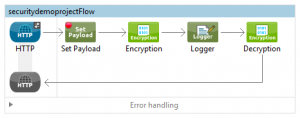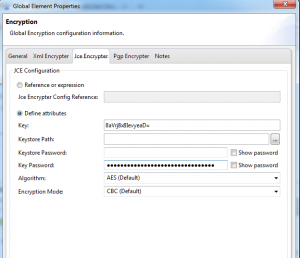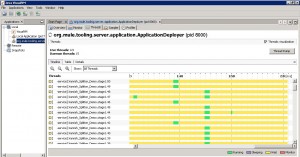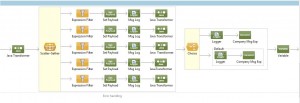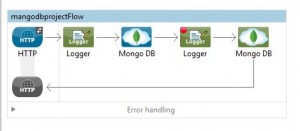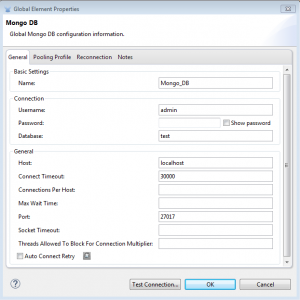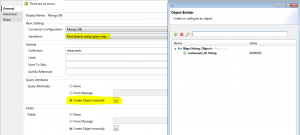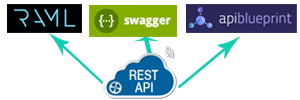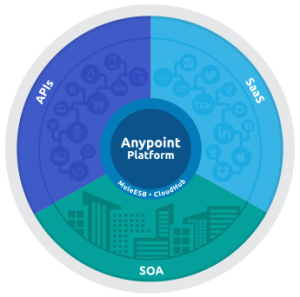1. Introduction
JBoss Messaging is a high performance JMS provider in the JBoss Enterprise Middleware Stack (JEMS). JBoss Messaging is the default JMS provider in JBoss AS 5.x and later.
2. Features
- A fully compatible and Sun certified JMS 1.1 implementation.
- A strong focus on performance, reliability and scalability with high output and low latency.
- Publish-subscribe and point-to-point messaging models.
- Topics that feed multiple message queues
- Persistent and non-persistent messages
- Guaranteed message delivery that ensures that messages arrive once and only once
- Transactional and reliable – supporting ACID semantics
- Customizable security framework based on JAAS
3. JBoss-JMS Configuration
3.1.Configuration-Queue
- Create queue-destination-service.xml file in \deploy\messaging folder for jboss 5.x
- Here is sample xml file
- <?xml version="1.0" encoding="UTF-8"?>
- <server>
- <mbean code="org.jboss.jms.server.destination.QueueService" name="jboss.messaging.destination:service=Queue,name=testQueue" xmbean-dd="xmdesc/Queue-xmbean.xml">
- <depends optional-attribute-name="ServerPeer">jboss.messaging:service=ServerPeer</depends>
- <depends>jboss.messaging:service=PostOffice</depends>
- <attribute name="SecurityConfig">
- <security>
- <role name="guest" read="true" write="true"/>
- <role name="publisher" read="true" write="true" create="false"/>
- <role name="noacc" read="false" write="false" create="false"/>
- </security>
- </attribute>
- </mbean>
- </server>
3.2.Configuration-Topic
- Create topic-destination-service.xml file in \deploy\messaging folder for jboss 5.x
- Here is sample xml file
- <?xml version="1.0" encoding="UTF-8"?>
- <server>
- <mbean code="org.jboss.jms.server.destination. TopicService" name="jboss.messaging.destination:service=Topic,name= testTopic" xmbean-dd="xmdesc/Queue-xmbean.xml">
- <depends optional-attribute-name="ServerPeer">jboss.messaging:service=ServerPeer</depends>
- <depends>jboss.messaging:service=PostOffice</depends>
- <attribute name="SecurityConfig">
- <security>
- <role name="guest" read="true" write="true"/>
- <role name="publisher" read="true" write="true" create="false"/>
- <role name="noacc" read="false" write="false" create="false"/>
- </security>
- </attribute>
- </mbean>
- </server>
4. JBoss-Oracle configuration for JMS
Create these tables in Oracle database
- CREATE TABLE JBM_DUAL (DUMMY INTEGER, PRIMARY KEY (DUMMY))
- CREATE TABLE JBM_MSG_REF (MESSAGE_ID INTEGER, CHANNEL_ID INTEGER, TRANSACTION_ID INTEGER, STATE CHAR(1), ORD INTEGER, PAGE_ORD INTEGER, DELIVERY_COUNT INTEGER, SCHED_DELIVERY INTEGER, PRIMARY KEY(MESSAGE_ID, CHANNEL_ID))
- CREATE INDEX JBM_MSG_REF_TX ON JBM_MSG_REF (TRANSACTION_ID, STATE)
- CREATE TABLE JBM_MSG (MESSAGE_ID INTEGER, RELIABLE CHAR(1), EXPIRATION INTEGER, TIMESTAMP INTEGER, PRIORITY INTEGER, TYPE INTEGER, HEADERS BLOB, PAYLOAD BLOB, PRIMARY KEY (MESSAGE_ID))
- CREATE TABLE JBM_TX (NODE_ID INTEGER, TRANSACTION_ID INTEGER, BRANCH_QUAL RAW(254), FORMAT_ID INTEGER, GLOBAL_TXID RAW(254), PRIMARY KEY (TRANSACTION_ID))
- CREATE TABLE JBM_COUNTER (NAME VARCHAR2(255), NEXT_ID INTEGER, PRIMARY KEY(NAME))
- CREATE TABLE JBM_ID_CACHE (NODE_ID INTEGER, CNTR INTEGER, JBM_ID VARCHAR2(255), PRIMARY KEY(NODE_ID, CNTR))
- CREATE TABLE JBM_POSTOFFICE (POSTOFFICE_NAME VARCHAR2(255), NODE_ID INTEGER, QUEUE_NAME VARCHAR2(255), COND VARCHAR2(1023), SELECTOR VARCHAR2(1023), CHANNEL_ID INTEGER, CLUSTERED CHAR(1), ALL_NODES CHAR(1), PRIMARY KEY(POSTOFFICE_NAME, NODE_ID, QUEUE_NAME))
- CREATE TABLE JBM_USER (USER_ID VARCHAR2(32) NOT NULL, PASSWD VARCHAR2(32) NOT NULL, CLIENTID VARCHAR2(128), PRIMARY KEY(USER_ID))
- CREATE TABLE JBM_ROLE (ROLE_ID VARCHAR2(32) NOT NULL, USER_ID VARCHAR2(32) NOT NULL, PRIMARY KEY(USER_ID, ROLE_ID))
In order to enable support for one of these databases, just replace the default hsqldb-persistence-service.xml configuration file with the Oracle database-specific configuration file in \deploy\messaging folder.
Here is oracle specific persistence file.
oracle-persistence-service.xml
- <?xml version="1.0" encoding="UTF-8"?>
- <!--
- Oracle persistence deployment descriptor.
- Tested with Oracle 10.2.0.1
- $Id$
- -->
- <server>
- <!-- Persistence Manager MBean configuration======================================== -->
- <mbean code="org.jboss.messaging.core.jmx.JDBCPersistenceManagerService" name="jboss.messaging:service=PersistenceManager" xmbean-dd="xmdesc/JDBCPersistenceManager-xmbean.xml">
- <depends>jboss.jca:service=DataSourceBinding,name=DefaultDS</depends>
- <depends optional-attribute-name="TransactionManager">jboss:service=TransactionManager</depends>
- <!-- The datasource to use for the persistence manager -->
- <attribute name="DataSource">java:/DefaultDS</attribute>
- <!-- If true will attempt to create tables and indexes on every start-up -->
- <attribute name="CreateTablesOnStartup">true</attribute>
- <!-- If true then we will automatically detect and reject duplicate messages sent during failover -->
- <attribute name="DetectDuplicates">true</attribute>
- <!-- The size of the id cache to use when detecting duplicate messages -->
- <attribute name="IDCacheSize">500</attribute>
- <!-- Some databases don't support inserting blobs using INSERT INTO ... SELECT FROM -->
- <attribute name="SupportsBlobOnSelect">false</attribute>
- <attribute name="SqlProperties"><![CDATA[
- CREATE_DUAL=CREATE TABLE JBM_DUAL (DUMMY INTEGER, PRIMARY KEY (DUMMY))
- CREATE_MESSAGE_REFERENCE=CREATE TABLE JBM_MSG_REF (MESSAGE_ID INTEGER, CHANNEL_ID INTEGER, TRANSACTION_ID INTEGER, STATE CHAR(1), ORD INTEGER, PAGE_ORD INTEGER, DELIVERY_COUNT INTEGER, SCHED_DELIVERY INTEGER, PRIMARY KEY(MESSAGE_ID, CHANNEL_ID))
- CREATE_IDX_MESSAGE_REF_TX=CREATE INDEX JBM_MSG_REF_TX ON JBM_MSG_REF (TRANSACTION_ID, STATE)
- CREATE_MESSAGE=CREATE TABLE JBM_MSG (MESSAGE_ID INTEGER, RELIABLE CHAR(1), EXPIRATION INTEGER, TIMESTAMP INTEGER, PRIORITY INTEGER, TYPE INTEGER, HEADERS BLOB, PAYLOAD BLOB, PRIMARY KEY (MESSAGE_ID))
- CREATE_TRANSACTION=CREATE TABLE JBM_TX (NODE_ID INTEGER, TRANSACTION_ID INTEGER, BRANCH_QUAL RAW(254), FORMAT_ID INTEGER, GLOBAL_TXID RAW(254), PRIMARY KEY (TRANSACTION_ID))
- CREATE_COUNTER=CREATE TABLE JBM_COUNTER (NAME VARCHAR2(255), NEXT_ID INTEGER, PRIMARY KEY(NAME))
- CREATE_ID_CACHE=CREATE TABLE JBM_ID_CACHE (NODE_ID INTEGER, CNTR INTEGER, JBM_ID VARCHAR2(255), PRIMARY KEY(NODE_ID, CNTR))
- INSERT_DUAL=INSERT INTO JBM_DUAL VALUES (1)
- CHECK_DUAL=SELECT 1 FROM JBM_DUAL
- INSERT_MESSAGE_REF=INSERT INTO JBM_MSG_REF (CHANNEL_ID, MESSAGE_ID, TRANSACTION_ID, STATE, ORD, PAGE_ORD, DELIVERY_COUNT, SCHED_DELIVERY) VALUES (?, ?, ?, ?, ?, ?, ?, ?)
- DELETE_MESSAGE_REF=DELETE FROM JBM_MSG_REF WHERE MESSAGE_ID=? AND CHANNEL_ID=? AND STATE='C'
- UPDATE_MESSAGE_REF=UPDATE JBM_MSG_REF SET TRANSACTION_ID=?, STATE='-' WHERE MESSAGE_ID=? AND CHANNEL_ID=? AND STATE='C'
- UPDATE_PAGE_ORDER=UPDATE JBM_MSG_REF SET PAGE_ORD = ? WHERE MESSAGE_ID=? AND CHANNEL_ID=?
- COMMIT_MESSAGE_REF1=UPDATE JBM_MSG_REF SET STATE='C', TRANSACTION_ID = NULL WHERE TRANSACTION_ID=? AND STATE='+'
- COMMIT_MESSAGE_REF2=DELETE FROM JBM_MSG_REF WHERE TRANSACTION_ID=? AND STATE='-'
- ROLLBACK_MESSAGE_REF1=DELETE FROM JBM_MSG_REF WHERE TRANSACTION_ID=? AND STATE='+'
- ROLLBACK_MESSAGE_REF2=UPDATE JBM_MSG_REF SET STATE='C', TRANSACTION_ID = NULL WHERE TRANSACTION_ID=? AND STATE='-'
- LOAD_PAGED_REFS=SELECT MESSAGE_ID, DELIVERY_COUNT, PAGE_ORD, SCHED_DELIVERY FROM JBM_MSG_REF WHERE CHANNEL_ID = ? AND PAGE_ORD BETWEEN ? AND ? ORDER BY PAGE_ORD
- LOAD_UNPAGED_REFS=SELECT MESSAGE_ID, DELIVERY_COUNT, SCHED_DELIVERY, PAGE_ORD FROM JBM_MSG_REF WHERE STATE = 'C' AND CHANNEL_ID = ? ORDER BY ORD
- LOAD_REFS=SELECT MESSAGE_ID, DELIVERY_COUNT, SCHED_DELIVERY FROM JBM_MSG_REF WHERE STATE = 'C' AND CHANNEL_ID = ? ORDER BY ORD
- UPDATE_REFS_NOT_PAGED=UPDATE JBM_MSG_REF SET PAGE_ORD = NULL WHERE PAGE_ORD BETWEEN ? AND ? AND CHANNEL_ID=?
- SELECT_MIN_MAX_PAGE_ORD=SELECT MIN(PAGE_ORD), MAX(PAGE_ORD) FROM JBM_MSG_REF WHERE CHANNEL_ID = ?
- UPDATE_DELIVERY_COUNT=UPDATE JBM_MSG_REF SET DELIVERY_COUNT = ? WHERE MESSAGE_ID = ? AND CHANNEL_ID = ?/li>
- UPDATE_CHANNEL_ID=UPDATE JBM_MSG_REF SET CHANNEL_ID = ? WHERE CHANNEL_ID = ?
- MOVE_REFERENCE=UPDATE JBM_MSG_REF SET CHANNEL_ID = ? WHERE MESSAGE_ID = ? AND CHANNEL_ID = ?
- LOAD_MESSAGES=SELECT MESSAGE_ID, RELIABLE, EXPIRATION, TIMESTAMP, PRIORITY, HEADERS, PAYLOAD, TYPE FROM JBM_MSG
- INSERT_MESSAGE=INSERT INTO JBM_MSG (MESSAGE_ID, RELIABLE, EXPIRATION, TIMESTAMP, PRIORITY, TYPE, HEADERS, PAYLOAD) VALUES (?, ?, ?, ?, ?, ?, ?, ?)
- INSERT_MESSAGE_CONDITIONAL=INSERT INTO JBM_MSG (MESSAGE_ID, RELIABLE, EXPIRATION, TIMESTAMP, PRIORITY, TYPE) SELECT ?, ?, ?, ?, ?, ? FROM JBM_DUAL WHERE NOT EXISTS (SELECT MESSAGE_ID FROM JBM_MSG WHERE MESSAGE_ID = ?)
- UPDATE_MESSAGE_4CONDITIONAL=UPDATE JBM_MSG SET HEADERS=?, PAYLOAD=? WHERE MESSAGE_ID=?
- INSERT_MESSAGE_CONDITIONAL_FULL=INSERT INTO JBM_MSG (MESSAGE_ID, RELIABLE, EXPIRATION, TIMESTAMP, PRIORITY, TYPE, HEADERS, PAYLOAD) SELECT ?, ?, ?, ?, ?, ?, ?, ? FROM JBM_DUAL WHERE NOT EXISTS (SELECT MESSAGE_ID FROM JBM_MSG WHERE MESSAGE_ID = ?)
- MESSAGE_ID_COLUMN=MESSAGE_ID
- DELETE_MESSAGE=DELETE FROM JBM_MSG WHERE MESSAGE_ID = ? AND NOT EXISTS (SELECT JBM_MSG_REF.MESSAGE_ID FROM JBM_MSG_REF WHERE JBM_MSG_REF.MESSAGE_ID = ?)
- INSERT_TRANSACTION=INSERT INTO JBM_TX (NODE_ID, TRANSACTION_ID, BRANCH_QUAL, FORMAT_ID, GLOBAL_TXID) VALUES(?, ?, ?, ?, ?)
- DELETE_TRANSACTION=DELETE FROM JBM_TX WHERE NODE_ID = ? AND TRANSACTION_ID = ?
- SELECT_PREPARED_TRANSACTIONS=SELECT TRANSACTION_ID, BRANCH_QUAL, FORMAT_ID, GLOBAL_TXID FROM JBM_TX WHERE NODE_ID = ?
- SELECT_MESSAGE_ID_FOR_REF=SELECT MESSAGE_ID, CHANNEL_ID FROM JBM_MSG_REF WHERE TRANSACTION_ID = ? AND STATE = '+' ORDER BY ORD
- SELECT_MESSAGE_ID_FOR_ACK=SELECT MESSAGE_ID, CHANNEL_ID FROM JBM_MSG_REF WHERE TRANSACTION_ID = ? AND STATE = '-' ORDER BY ORD
- UPDATE_COUNTER=UPDATE JBM_COUNTER SET NEXT_ID = ? WHERE NAME=?
- SELECT_COUNTER=SELECT NEXT_ID FROM JBM_COUNTER WHERE NAME=? FOR UPDATE
- INSERT_COUNTER=INSERT INTO JBM_COUNTER (NAME, NEXT_ID) VALUES (?, ?)
- SELECT_ALL_CHANNELS=SELECT DISTINCT(CHANNEL_ID) FROM JBM_MSG_REF
- UPDATE_TX=UPDATE JBM_TX SET NODE_ID=? WHERE NODE_ID=?
- UPDATE_ID_IN_CACHE=UPDATE JBM_ID_CACHE SET JBM_ID = ? WHERE NODE_ID = ? AND CNTR = ?
- INSERT_ID_IN_CACHE=INSERT INTO JBM_ID_CACHE (NODE_ID, CNTR, JBM_ID) VALUES (?, ?, ?)
- LOAD_ID_CACHE=SELECT CNTR, JBM_ID FROM JBM_ID_CACHE WHERE NODE_ID = ?
- ]]></attribute>
- <!-- The maximum number of parameters to include in a prepared statement -->
- <attribute name="MaxParams">500</attribute>
- </mbean>
- <!-- Messaging Post Office MBean configuration========================================= -->
- <mbean code="org.jboss.messaging.core.jmx.MessagingPostOfficeService" name="jboss.messaging:service=PostOffice" xmbean-dd="xmdesc/MessagingPostOffice-xmbean.xml">
- <depends optional-attribute-name="ServerPeer">jboss.messaging:service=ServerPeer</depends>
- <depends>jboss.jca:service=DataSourceBinding,name=DefaultDS</depends>
- <depends optional-attribute-name="TransactionManager">jboss:service=TransactionManager</depends>
- <!-- The name of the post office -->
- <attribute name="PostOfficeName">JMS post office</attribute>
- <!-- The datasource used by the post office to access it's binding information -->
- <attribute name="DataSource">java:/DefaultDS</attribute>
- <!-- If true will attempt to create tables and indexes on every start-up -->
- <attribute name="CreateTablesOnStartup">true</attribute>
- <attribute name="SqlProperties"><![CDATA[
- CREATE_POSTOFFICE_TABLE=CREATE TABLE JBM_POSTOFFICE (POSTOFFICE_NAME VARCHAR2(255), NODE_ID INTEGER, QUEUE_NAME VARCHAR2(255), COND VARCHAR2(1023), SELECTOR VARCHAR2(1023), CHANNEL_ID INTEGER, CLUSTERED CHAR(1), ALL_NODES CHAR(1), PRIMARY KEY(POSTOFFICE_NAME, NODE_ID, QUEUE_NAME))
- INSERT_BINDING=INSERT INTO JBM_POSTOFFICE (POSTOFFICE_NAME, NODE_ID, QUEUE_NAME, COND, SELECTOR, CHANNEL_ID, CLUSTERED, ALL_NODES) VALUES (?, ?, ?, ?, ?, ?, ?, ?)
- DELETE_BINDING=DELETE FROM JBM_POSTOFFICE WHERE POSTOFFICE_NAME=? AND NODE_ID=? AND QUEUE_NAME=?
- LOAD_BINDINGS=SELECT QUEUE_NAME, COND, SELECTOR, CHANNEL_ID, CLUSTERED, ALL_NODES FROM JBM_POSTOFFICE WHERE POSTOFFICE_NAME=? AND NODE_ID=?
- ]]></attribute>
- <!-- This post office is non clustered. If you want a clustered post office then set to true -->
- <attribute name="Clustered">false</attribute>
- <!-- All the remaining properties only have to be specified if the post office is clustered.You can safely comment them out if your post office is non clustered -->
- <!-- The JGroups group name that the post office will use -->
- <attribute name="GroupName">${jboss.messaging.groupname:MessagingPostOffice}</attribute>
- <!-- Max time to wait for state to arrive when the post office joins the cluster -->
- <attribute name="StateTimeout">30000</attribute>
- <!-- Max time to wait for a synchronous call to node members using the MessageDispatcher -->
- <attribute name="CastTimeout">30000</attribute>
- <!-- Set this to true if you want failover of connections to occur when a node is shut down -->
- <attribute name="FailoverOnNodeLeave">false</attribute>
- <depends optional-attribute-name="ChannelFactoryName">jboss.jgroups:service=ChannelFactory</depends>
- <attribute name="ControlChannelName">jbm-control</attribute>
- <attribute name="DataChannelName">jbm-data</attribute>
- <attribute name="ChannelPartitionName">${jboss.partition.name:DefaultPartition}-JMS</attribute>
- </mbean>
- <!-- Messaging JMS User Manager MBean config======================================= -->
- <mbean code="org.jboss.jms.server.plugin.JDBCJMSUserManagerService" name="jboss.messaging:service=JMSUserManager" xmbean-dd="xmdesc/JMSUserManager-xmbean.xml">
- <depends>jboss.jca:service=DataSourceBinding,name=DefaultDS</depends>
- <depends optional-attribute-name="TransactionManager">jboss:service=TransactionManager</depends>
- <attribute name="DataSource">java:/DefaultDS</attribute>
- <attribute name="CreateTablesOnStartup">true</attribute>
- <attribute name="SqlProperties"><![CDATA[
- CREATE_USER_TABLE=CREATE TABLE JBM_USER (USER_ID VARCHAR2(32) NOT NULL, PASSWD VARCHAR2(32) NOT NULL, CLIENTID VARCHAR2(128), PRIMARY KEY(USER_ID))
- CREATE_ROLE_TABLE=CREATE TABLE JBM_ROLE (ROLE_ID VARCHAR2(32) NOT NULL, USER_ID VARCHAR2(32) NOT NULL, PRIMARY KEY(USER_ID, ROLE_ID))
- SELECT_PRECONF_CLIENTID=SELECT CLIENTID FROM JBM_USER WHERE USER_ID=?
- POPULATE.TABLES.1 = INSERT INTO JBM_USER (USER_ID, PASSWD) VALUES ('guest', 'guest')
- POPULATE.TABLES.2 = INSERT INTO JBM_USER (USER_ID, PASSWD) VALUES ('j2ee', 'j2ee')
- POPULATE.TABLES.3 = INSERT INTO JBM_USER (USER_ID, PASSWD, CLIENTID) VALUES ('john', 'needle','DurableSubscriberExample')
- POPULATE.TABLES.4 = INSERT INTO JBM_USER (USER_ID, PASSWD) VALUES ('nobody', 'nobody')
- POPULATE.TABLES.5 = INSERT INTO JBM_USER (USER_ID, PASSWD) VALUES ('dynsub', 'dynsub')
- POPULATE.TABLES.6 = INSERT INTO JBM_ROLE (ROLE_ID, USER_ID) VALUES ('guest','guest')
- POPULATE.TABLES.7 = INSERT INTO JBM_ROLE (ROLE_ID, USER_ID) VALUES ('j2ee','guest')
- POPULATE.TABLES.8 = INSERT INTO JBM_ROLE (ROLE_ID, USER_ID) VALUES ('john','guest')
- POPULATE.TABLES.9 = INSERT INTO JBM_ROLE (ROLE_ID, USER_ID) VALUES ('subscriber','john')
- POPULATE.TABLES.10 = INSERT INTO JBM_ROLE (ROLE_ID, USER_ID) VALUES ('publisher','john')
- POPULATE.TABLES.11 = INSERT INTO JBM_ROLE (ROLE_ID, USER_ID) VALUES ('publisher','dynsub')
- POPULATE.TABLES.12 = INSERT INTO JBM_ROLE (ROLE_ID, USER_ID) VALUES ('durpublisher','john')
- POPULATE.TABLES.13 = INSERT INTO JBM_ROLE (ROLE_ID, USER_ID) VALUES ('durpublisher','dynsub')
- POPULATE.TABLES.14 = INSERT INTO JBM_ROLE (ROLE_ID, USER_ID) VALUES ('noacc','nobody')
- ]]></attribute>
- </mbean>
- </server>
Open \conf\login-config.xml and add these lines
- <application-policy name = "messaging">
- <authentication>
- <login-module code = "org.jboss.security.auth.spi.DatabaseServerLoginModule" flag = "required" >
- <module-option name = "unauthenticatedIdentity">guest</module-option>
- <module-option name = "dsJndiName">java:/jdbc/ProfilesDS</module-option>
- <module-option name = "principalsQuery">
- SELECT PASSWD FROM JBM_USER WHERE USER_ID=?
- </module-option>
- <module-option name = "rolesQuery">
- SELECT ROLE_ID, 'Roles' FROM JBM_ROLE WHERE USER_ID=?
- </module-option>
- </login-module>
- </authentication>
- </application-policy>
